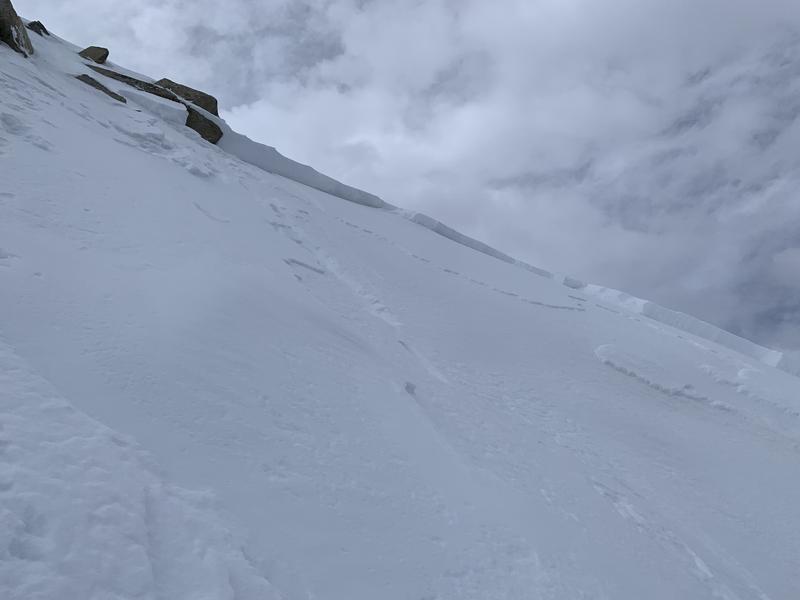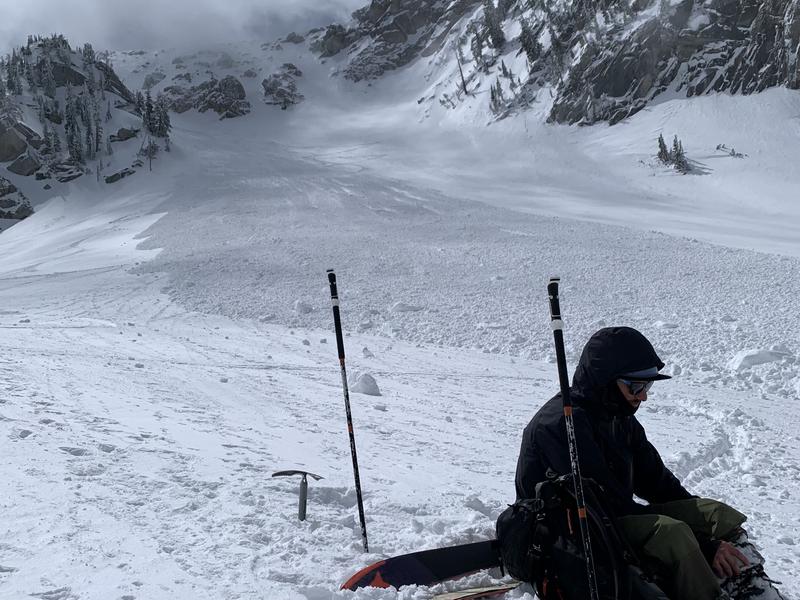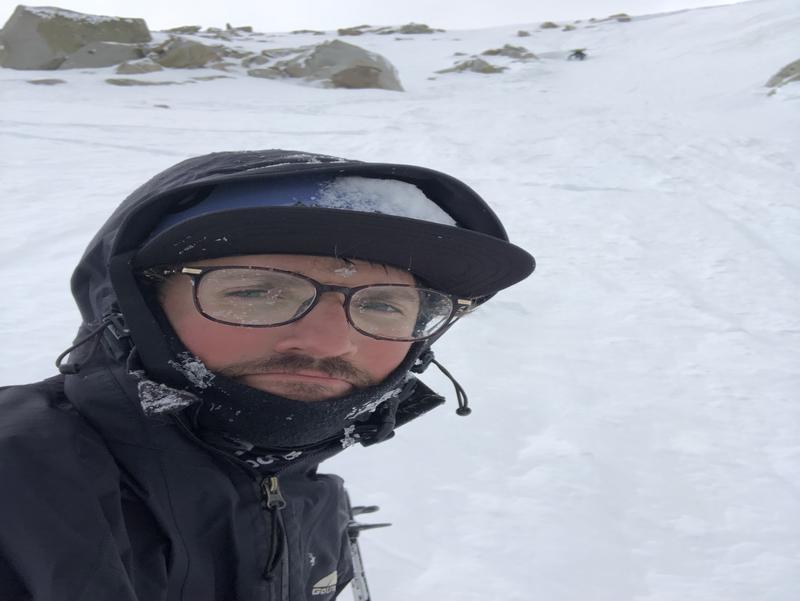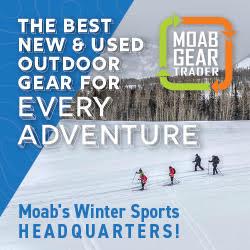Observer Name
Ethan Niederhauser
Observation Date
Thursday, May 9, 2024
Avalanche Date
Thursday, May 9, 2024
Region
Salt Lake » Bells Canyon
Location Name or Route
Bells Cleaver
Elevation
10,400'
Aspect
North
Trigger
Skier
Trigger: additional info
Unintentionally Triggered
Avalanche Type
Soft Slab
Avalanche Problem
Wind Drifted Snow
Weak Layer
Density Change
Depth
2'
Width
50'
Caught
1
Carried
1
Comments
On May 9th, around 11:15 a.m., I was caught and carried by an avalanche off of Bells Cleaver. With me was my buddy Steve. We both wrote our experiences before the preliminary report of the Big Willow incident was published. Seeing how almost identical these incidents were is hittig us both heavier than we expected. Here is our story:
[ETHAN]
This is hard for me to write. However, In light of the events that have transpired today, I believe it is important to share my story, and the thoughts I have surrounding it.
This morning, Thursday May 9th, I set out on a mission to ski the Bells Cleaver with Steve. For context, I’ve never skied with Steve. He and I connected a few months ago but had been unable to make a ski-tour work until today. I told him that even if it sucked, it would still be fun. Now, I’m not so sure if that’s true.
We departed the Bell Canyon trailhead at 4:30am this morning, anxious to get up into the alpine and attempt a few lines before the weather window closed. Although we had never been out together, we immediately formed a bond of trust. Right out of the gate we were discussing safe travel protocols and the potential challenges of the snowpack up there.
After getting up into the meadow above the second falls, we had a good look at our line, and proceeded to turn on beacons. I couldn’t believe it; my beacon was wigging out on me with an Er message flashing across the screen. It had worked fine just yesterday, what changed? Had I accidentally left it on the night before and drained my batteries? Steve offered me some spare batteries, and we both looked at each other, knowing full well that if this didn’t work, our little adventure was going to be cut real short. BEEP! 99%...nice, we’re good to keep moving.
After ascending out of the meadow and onto the upper bench enroute to the north face of Bells Cleaver, the stoke quickly began to manifest. The snow had stayed cold and dry all night, we had good visibility and what looked like good stability. Even a cloud coming in and socking in our vision couldn’t deter us. The cloud dispersed and we began ascending the chute to the direct left of the north face. We both kept an eye on the surface stability, doing hand shear tests every couple hundred feet to make sure we didn’t miss anything. Upon entering the chute and switching to boot back, we both agreed to helmet up for safety, and pull out our ice-axes when the snow surface got firmer.
With the last dozen or so feet left to the ridge, I began wallowing thigh deep in various densities of snow. In my mind this should have been an obvious sign of wind loading, but I kept moving forward, perhaps blinded by how close we were to the summit ridge. Without either of us really even mentioning safe spots or segmenting, Steve instinctively hunkered down next to the rocks forty feet below and waited for me to top out. That’s when it happened.
I heard a massive whumph, and instantaneously felt like I was on the Rocket at Lagoon. You know, the one where they drop you from the very top of a tower without warning? The only problem with this analogy was that I wasn’t strapped into anything. I immediately began frantically shoving my axe into the snow trying to punch through but was met only with soft wind slab. Steve started shouting at me, which I heard for a split second, then it was drowned out by own expletives, and my face being engulfed in snow as I rocketed down the slope. At this point the slide had barrel-rolled me multiple times and I ended up on my back careening at high speed down the couloir, right in the trajectory of the jagged rocks where the chute makes an abrupt turn. There was no time to think, but my instinct was screaming at me “SELF ARREST! SELF ARREST!” This was an technique I had learned over 16 years ago in an alpine mountaineering class, and yet this was the first time in my life I had actually needed to use it.
After hastily rolling myself onto my stomach, I death gripped my axe and forced it through the shattering soft snow, finding the hard layer beneath. Then I put all of weight into it, while furiously trying kick into the snow surface with my boots. While my axe began to find purchase, the force of the slide debris continued to bear down on me, and at the speed I was going, my feet were bouncing off the snow surface like skipping rocks. The force was so great that I thought I was going to break my legs . Then just like that, the last remnants of the debris slid past me. All told, this took place in about 8-10 seconds. I slid a little over 200 feet of the 800 vertical foot face. But people are definitely not lying when they say time slows down when you’re in an avalanche…it felt like an eternity.
Steve was yelling to me from above, asking if I was alright, but I struggled to respond, as I was gasping for breath while shaking uncontrollably. Eventually I was able to point a thumbs up, even though I had no idea if I was ok or not. I fortunately ended up with just a sore back and a sprained right middle finger from death gripping my ice-axe like my life depended on it. Steve snowboarded down to me and, while still shaking, I gave him a big ol’ bear hug. For those who don’t know me, I’ve always struggled with forming meaningful connections with people, and showing affection falls into that category. Somehow Steve managed to skip right past what only a select few of my friends have accomplished with me in years, and he did it in only a few short hours too. Impressive to say the least.
He informed me that while barrel-rolling one of my skis had ripped off my pack and was somewhere in the pile of slide debris now resting 600 ft below us (I thought that my pack had felt lighter for some reason). But right then I didn’t care, I was just grateful for my life. Looking up at the crown face, then down at the debris pile, it was unbelievable how big this thing had ripped.
When it initially started carrying me, I thought that I had set off a small surface slab that threatened to send me careening into the rock walls below, but the last thing on my mind was that it was big enough to bury me. Once I saw the true magnitude of it, I knew that this was more than just a small screw up on my part. This was a 1–2-foot crown, roughly 50 feet in width, and with a runout of about 750 vertical feet. I feel like I’ve said it to myself a thousand time in the last 15 years, “Wind slabs form on the leeside of ridges. Wind slabs form on the leeside of ridges….” What the heck was I thinking?? We had all of the telltale signs, all of the red flags, but I chose to be oblivious to them because of this trap I had set for myself in being overly confident and “summit hungry.”
After descending the couloir in “mono-ski mode,” and being greeted by my lost ski that Steve had miraculously found on the surface of the debris pile, we rested a bit. There were definitely some strong emotions shared as we started coming to terms with what had just happened. That’s when the helicopters started flying overhead.
We couldn’t wrap our heads around it; had someone seen our avalanche from the valley and then called search and rescue? No way, that’s absurd…then my phone started blowing up with texts. People were asking me if I was ok, sending me links to a rescue effort going down in Big Willow, just the next drainage over. We weren’t sure what to make of it, but as we descended Bell Canyon more news began to come in.
First it was three skiers buried, which made our hearts sink. Then it was one skier recovered, which gave us a little hope. Then, as we made the final decent to the trailhead we could hear the distinct booming of explosives, a sound I deduced as bombs for avalanche control, something I was very familiar with hearing around ski resorts, but had never heard a long the Wasatch Front. We presumed that the only explanation was that the search teams were working to mitigate any additional avalanche danger while they worked to recover the bodies.
The passing of the two other skiers would later be confirmed to us by a news article as soon as we arrived at the cars. There was no celebration, no high-fives of relief that we had made it back in one piece. For a good while, we sat silent in the parking lot, emotions running high as we struggled to grapple with this news. Why wasn’t that us? That could’ve easily been us. It was just the other drainage over, same aspect, similar slope, similar elevation. Our avalanche occurred at approximately 11:15 am, theirs was reported at 10:15, just an hour before. What in the world did we do differently that allowed us to get out safely? Was it just dumb luck?
It's a strange situation to be in, to end up completely safe and sound at the end of the day, but still feel sick to my stomach that others weren’t so lucky. My feelings are torn right now between sadness and gratitude...but I also can’t help but feel somewhat paralyzed by the “What ifs.” What if Steve had been standing a few feet to his right and been caught in the slide too? What if we forgot to put our helmets on while climbing the chute? What if I hadn’t taken my axe out when the booting became more firm? What if we had just made the call to turn around in the first place, right when we encountered the first signs of cross loading?
I know that, ultimately, the “What ifs” will do nothing for me, as we can’t change the past. But I think that our incident can at least open a discussion on the merits of "turning around." Seems that these days, half of the cars parked at White Pine have the words “Hypodermic Needle or Bust” carved into them, which assumes that exposing seven groups in one chute at the same time is worth dying for. As for me, I’ve become well acquainted with bailing on objectives in years past, but honestly, I can’t think of a single time this spring where turning around was even a part of the discussion. In the end, every one of those objectives worked out for me…until today. Was it worth it?
That’s where I’m at right now, questioning how all of this is even worth it. How can I justify all of this given what we’ve seen today? This sport, spending time in the mountains while skiing amazing lines in great snow, has been one of the most worthwhile pursuits of my life. I have loved it now for more than half of my life.
I love our community here; we look out for each other. If someone sees something sketchy, they pass the word along. We give beta to people on where to find good snow and terrain; we post our observations on to UAC. Whether you’re a splitboarder or skier or even snowshoe,, I genuinely feel like we are our own tribe…and we just lost two members of our tribe today. It doesn't matter that I didn't know the know the victims. Given that we were in such close proximity when these incidents happened, I feel a strange connection to them. And it hurts.
There’s still going to be a lot to unpack from all of this. I know that Steve and I are still going to be unpacking stuff from our incident for a long time to come and will continue to update ourselves as new information becomes available from the incident today in Big Willow. I think, at least for right now, I’m going to try to refocus my attention on gratitude. Gratitude for what I have, gratitude for the blessing of finding peace of mind in the outdoors, gratitude for having walked away from a pretty colossal mistake with a hard lesson not yet learned.
After getting back I drove to my parents house, and just laid out flat on the couch telling my mom about everything that had transpired that day and the things that I was grappling with. If I'm going to somehow pull myself together and keep doing this, how can I assure my family that the decisions I make are the right ones, given all that has happened? Steve and I have an entire summer and fall now to contemplate our decisions and work on refining our process. But it's still tremendously hard to think that two guys just like us won't have that chance. Where do we go from here?
I asked my Mom if she thought a good Mother’s Day gift would be if I agreed to finally hang up the skis for the season. She didn't say anything, she just chuckled…but it was kind of an affirming chuckle. So, I think to show my gratitude for everything she’s done for me, and to show my respects to those who passed today, I’m going to do just that. Maybe I’ll even get her a box of chocolates or something as well.
[STEVE]
A couple weeks ago, as I was driving south on I-15, I could make out the distinct north face of Bells Cleaver. Not
knowing what the face was called but being inspired by its prominence and potential for worthy ski objectives, I
vowed to 1) learn more about it and 2) hopefully ride it soon. I didn’t think much about it again until Wednesday
May 8, when I received a text from Ethan.
I met Ethan a couple months back through a mutual friend in Mineral Fork. He expressed that he was looking for
partners that were willing and eager to venture into backcountry zones that were a little more removed from the
hustle and bustle that the Central Wasatch can be. Since that interaction, we had made several attempts to ski
together but our schedules did not align.
On Wednesday May 8, Ethan texted me, again inviting me to ski. He mentioned Bells Cleaver. At this point, I still
hadn’t found out the name of the face that I had seen from the freeway a couple weeks back. I did some quick
google searching and it hit me: this was it. Having toured a couple days earlier, I was excited about the prospect of
getting to ride this line in really good conditions. I responded, “Word. Yeah, let’s do it.”
Despite very limited interactions with one another prior to this, Ethan and I jibed well. We quickly established a
relationship of trust by sharing both personal and backcountry experiences. As we ascended, we discussed the
changing snow conditions – wet, dense snow transitioning to cold, dry powder. In May. It was unbelievable. Upon
entering the cirque, the stoke was high. At this point, our biggest concern was that of visibility. Clouds were moving
in but would dissipate just as quickly as they appeared. We started the switchbacks up the apron. As we entered the
lower portion of the chute, we encountered a crust layer on skiers right. We decided we would continue skinning,
but on skiers left, where we could not feel this layer. As we worked our way up skiers left, we encountered some
cracking when performing kick turns, and evidence of wind effected snow. We performed hand shear tests and
determined, however, that the snow deposited from winds was 1) not cohesive and 2) not breaking on a consistent
plane. We discussed what we were observing. I think at one point I said something to the effect of, “We need to
keep our eye on this as we continue to climb.”
When the skinning got too steep, we transitioned to boot-packing. I attached my splitboard to my backpack, not
performing a complete transition to downhill mode. Ethan mentioned we should probably segment out the final
section, but there was no discussion regarding an acceptable distance that we should maintain from one another.
Ethan transitioned quicklier than I did and immediately began ascending next to a rocky rib on skiers right. As Ethan
approached the ridge, he had to traverse into the chute to get around a rocky outcropping. He navigated a granite
slab, that he notified me of. I took a break, some 40 feet below him in the bootpack, to observe the clouds
dispersing. Behind me, for the first time that day I could see Broads Fork Twin Peaks. I was reminded, as I have
been many times, of the beauty that is the Wasatch. Seconds later, the snow collapsed, and Ethan was sent tumbling.
Watching Ethan tumble was incredibly scary. He fought hard. I yelled at him, “F$@!, come on man!” as if willing
him to get himself right and to stay on top. Despite getting pummeled with large chunks of slab that broke at the
crown, somehow, he managed to slow his fall and self-arrest. As he came to a stop, one of his skis was stripped from
his pack and slid down the chutes apron. As I watched it, I was in awe at the amount of debris that was accumulating
at the bottom of the run. At this point I didn’t want to think about what-ifs…I just wanted to get down to Ethan. I
needed to hug him – just as much for him as it was for me.
My initial reaction was to descend by booting down. Upon closer examination, I realized that 10 feet below where I
stood was stripped by the avalanche, leaving no trace of our ascent booter. Additionally, there was a fracture
immediately below where I stood that did not release until I began booting down. I was standing on an island, that
for whatever reason, did not slide with the rest of the avalanche. Downward progress was slow, and as a result I
decided I should just transition and ride down to Ethan some 150 feet below.
I met up with Ethan. We hugged, and somewhat at a loss for words, decided that I should descend the remainder of
the run to retrieve his ski. It wasn’t until I reached the bottom of the slide that I started to realize how lucky we had
been. The slide went big. It tears me apart to know that another party had a different outcome, that they weren’t so
lucky - man, that word feels so inappropriate. The similarities between the Big Willow Cirque accident and our
experience just feel so f@$!&d up. Same aspect. Same elevation. Similar time. Just the drainage over. Despite an
overwhelming sense of gratitude for mine and Ethan’s safety, my heart hurts deeply for those affected by the tragedy
in Big Willow Cirque.
There’s a lot to unpack with this experience, but a few key takeaways for me are the following:
1. Complacency kills: It can happen to YOU.
2. Be prepared to initiate a rescue, ALWAYS: When I transitioned to bootpacking, I kept skins on my
splitboard and did not perform a complete transition. Had Ethan been buried, having my splitboard in
downhill mode could have meant the difference between life and death.
3. No communication is too much communication: Changes in snow conditions/consistency should always be
noted out loud, to a partner, especially in consequential terrain. Additionally, clear segmenting protocols
and safe zones should be identified.




Coordinates



